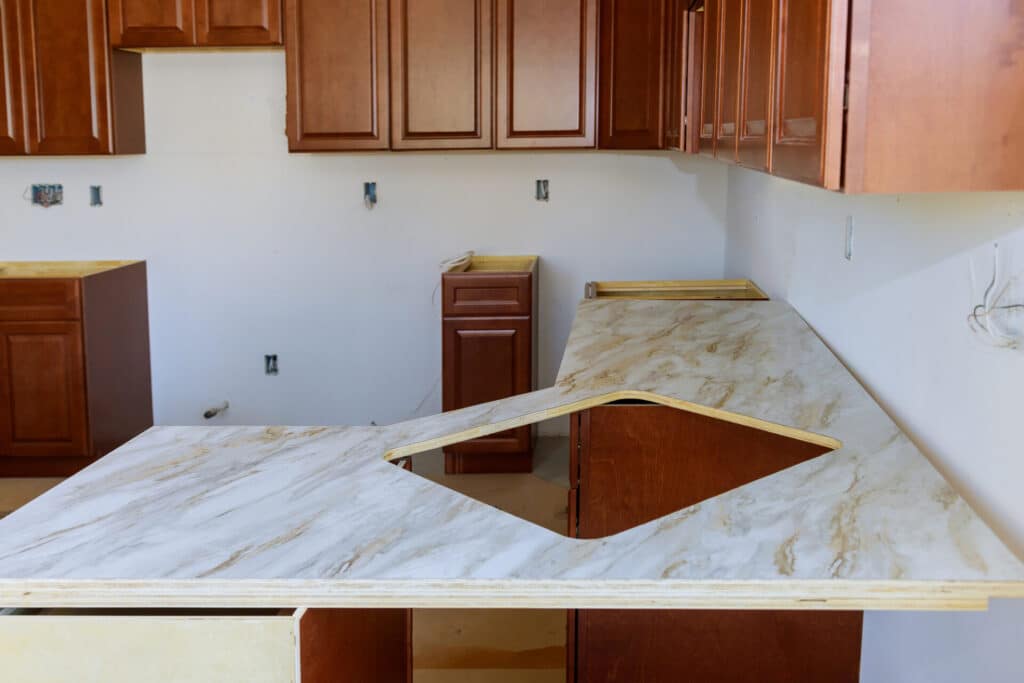
Laminate countertops have been a popular and affordable choice for kitchens and bathrooms for many years. They are durable, easy to clean, and come in a broad range of colors and patterns. However, over time the laminate may become outdated or damaged, leaving homeowners looking for ways to update their countertops. One question that often comes up is whether it is possible to put new laminate over old laminate countertops. In this article, let’s explore this topic and provide you with everything you need to know about this process.
Before we delve into the answer to this question, let’s first cover the basics of laminate countertops. Laminate countertops are made of layers of kraft paper infused with resin, which is then bonded to a particleboard or plywood core. The top layer is a thin sheet of decorative laminate that gives the countertop its color and pattern. This layered construction makes laminate countertops durable and resistant to stains, heat, and water.
Now, let’s address the main question at hand: can you put new laminate over old laminate countertops? The short answer is yes. It is possible to do so. However, there are a few factors to consider before deciding whether this is the best option for your kitchen remodeling or bathroom remodeling.
Factors to Consider
1. Condition of the existing laminate:
Before installing the new laminate over the old one, you need to evaluate the condition of the existing laminate. If the old laminate is peeling, chipped, or severely damaged, it is not suitable for overlaying. The new laminate needs a stable and flat surface to adhere properly. Any bumps, cracks, or imperfections in the old laminate will transfer to the new one, compromising the overall appearance and longevity of the countertops.
2. Thickness and weight:
Another factor to consider is the thickness and weight of the new laminate. Adding multiple layers of laminate to the existing countertop might result in a thicker surface, which could cause issues with the fit of appliances, such as dishwashers or stovetop ranges. Additionally, the added weight might put a strain on the cabinets or supports beneath the countertops. Ensure that your cabinets are sturdy enough to support the additional weight before proceeding with overlaying the laminate.
3. Edge profiles:
One aspect that may be affected by overlaying laminate is the edge profiles of the countertops. If the old laminate has a built-in or custom edge, overlaying the new laminate may cover or alter the existing profile. This can result in a loss of detail or a change in the look and feel of the countertop edges. If a specific edge profile is important to you, carefully consider how it will be affected by adding a new laminate.
If you have assessed these factors and determined that overlaying new laminate is a viable option, you can proceed with the following steps:
1. Prepare the surface:
Begin by thoroughly cleaning the existing laminate countertops to remove any dirt, grease, or debris. Use a mild household cleaner or a solution of warm water and mild dish soap. Rinse the surface well and allow it to completely dry.
2. Roughen the surface:
To help the new laminate adhere to the old laminate, it is recommended to roughen the surface. Use sandpaper or a sanding block to lightly sand the existing laminate countertops. This will create a slightly rough texture and improve the bond between the old and new laminate. Be sure to remove any dust created by sanding before proceeding to the next step.
3. Apply contact cement:
Contact cement is the adhesive of choice when installing laminate countertops. Apply a thin, even layer of contact cement to both the old laminate and the backside of the new laminate sheets. Follow the manufacturer’s instructions for the appropriate drying time.
4. Align and install the new laminate:
Carefully place the new laminate sheet over the old laminate, aligning it to ensure a proper fit. It is essential to take your time during this step to ensure a precise and even placement. Once aligned, gradually lower the laminate onto the old laminate, smoothing it out as you go. This can be done using a laminate roller or a clean, lint-free cloth. Apply even pressure to remove any air bubbles and ensure a solid bond between the two layers of laminate.
5. Trim and finish the edges:
After the new laminate has been installed, it is essential to trim and finish the edges to create a polished look. Use a router with a laminate trimming bit to trim away the excess laminate from the edges. Take care to follow the desired edge profile and make clean, smooth cuts. After trimming, use a file or sandpaper to smooth the edges and create a finished appearance.
6. Clean and seal the countertops:
Once the laminate has been installed and the edges finished, clean the countertops again to remove any adhesive residue or dust. Afterward, apply a laminate seam sealer to the edges to prevent moisture from seeping between the layers. This will help prolong the life of the laminate and ensure a durable and water-resistant surface.
It is important to note that while overlaying new laminate over old laminate can be a cost-effective way to update your countertops, it is not a permanent solution. Over time, the new laminate may suffer from wear and tear, just like any other countertop surface. It is always a good idea to practice proper countertop maintenance and avoid exposing the surface to excessive heat, sharp objects, or harsh chemicals to maximize its lifespan.
In conclusion, putting new laminate over old laminate countertops is indeed possible, but it requires careful consideration of the existing laminate’s condition, thickness, weight, and edge profiles. If these factors are favorable, and you are willing to invest time and effort into the installation process, overlaying new laminate can be a viable solution for giving your countertops a fresh and updated appearance. Just be sure to follow the recommended steps and take proper care of your laminate countertops to ensure their longevity and durability.
